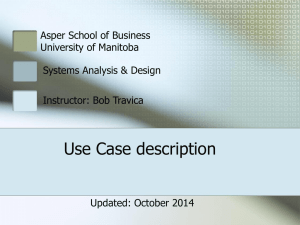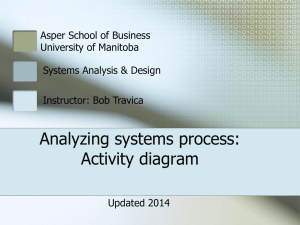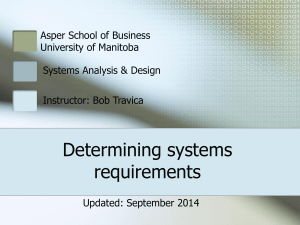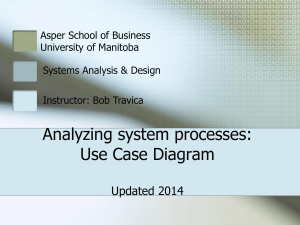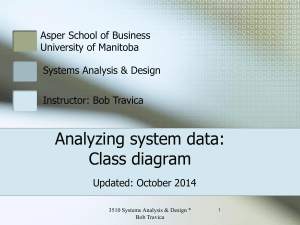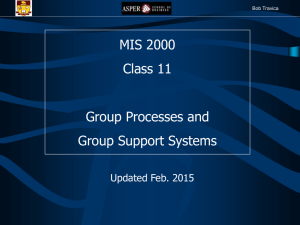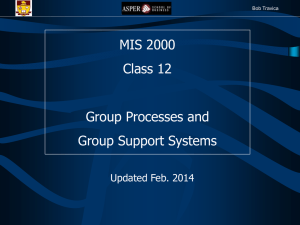Analyzing system data: Class Diagram
advertisement
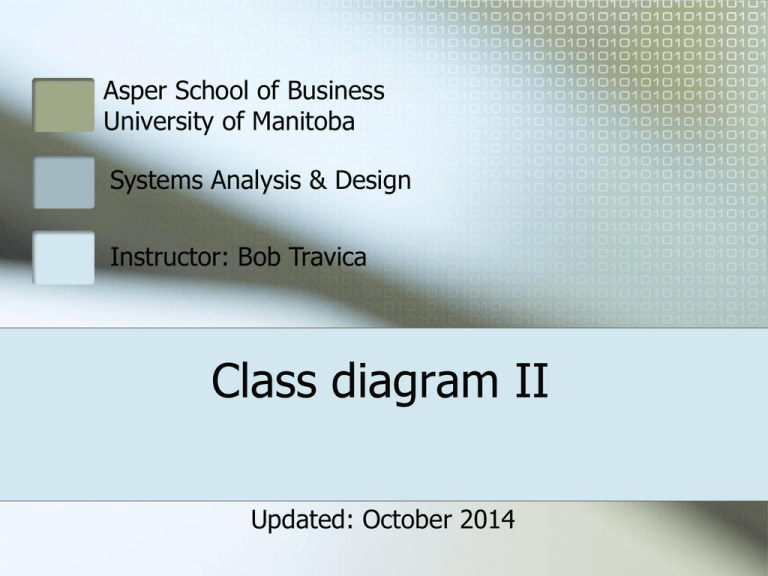
Asper School of Business University of Manitoba Systems Analysis & Design Instructor: Bob Travica Class diagram II Updated: October 2014 Outline More on associations & multiplicity Association class Fully developed classes Completing procedure for creation of class diagrams 3510 Systems Analysis & Design * Bob Travica 2 of 9 Associations Association types determined by maximum multiplicity (if 2 symbols for multiplicity provided, read that on the right) One-to-one (1:1) - occasional; e.g., Customer—CustomerBillingAddress One-to-many (1:M) - most frequent; for example: Customer—Order (or Customer--SaleTransaction) Many-to-many (M:M) - moderately frequent; examples: Order—Product (or Item), Employee—Project 3510 Systems Analysis & Design * Bob Travica 3 of 9 Multiplicity (more) Multiplicity question: Each (one) object on the left side of a relationship can be associated with how many objects on the right side? Then, write the number on right side. - Rule: Usually, the same movie plays in several theatres. Movie (1, assumed) * Theatre Each (one) object on the right side can be associated with how many objects on the left side? Then, right the number on left side. - Rule: Most theaters play several movies in a day. Movie * (1, assumed) Theatre 3510 Systems Analysis & Design * Bob Travica 4 of 9 Association class* Two ways to think about it: 1) A class that stores some extra attributes that characterize (belong to) the association between classes. term 2) Extra storage for data that do not fit into either of associated classes. 3510 Systems Analysis & Design * Bob Travica 5 of 9 RMO CRM system class diagram (simplified) Figure 8-9 modified Catalog CatalogItem productPrice CatalogID * has * * Item delivered by 1 has * ItemID ItemItemNumber ItemOrder quantity discount ItemShipment quantity appears on ShipmentNum delivered * by 1 Shipper ShipperID * Customer * Shipment InventoryItem * CustomerID Customary simplification, showing: - Just maximum multiplicity - Just attributes of Association Classes 1 places * Order OrderNum Optional naming of association classes: CatalogDetail, OrderDetail… (Note word “Detail”). • Association class contains transaction data. • In reading multiplicity neglect association classes! 3510 Systems Analysis & Design * Bob Travica 6 of 9 Fully developed classes (design level) Figure 8-7 Attributes - = private + = public () = attribute affected by, input data : string, number = data type 3510 Systems Analysis & Design * Bob Travica Methods 7 of 9 Sources for class diagramming Sources: Description (narrative) Use case diagrams & descriptions Analysis of master data and transactional data 3510 Systems Analysis & Design * Bob Travica 8 of 9 Completing a class diagram 1. 2. 3. 4. 5. 6. 7. Standard procedure: List classes List attributes Draw simplified class rectangles (name and attribute segments only) Insert attributes in class rectangles Determine keys Draw associations and name them (New) Draw Association Class for each relationship that has attribute(s) on its own. Note: For now it is important to recognize M:M relationship, not entire multiplicity. 3510 Systems Analysis & Design * Bob Travica
